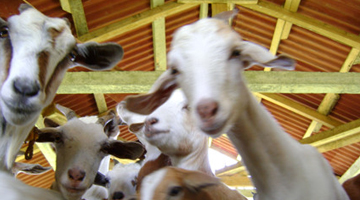 The “Rural Enterprise Development through Innovative Goat Production System” placed first in the development categories of the recently held Regional Symposium on Research and Development Highlights (RSRDH) in Regions 2, 3, and 8.
The “Rural Enterprise Development through Innovative Goat Production System” placed first in the development categories of the recently held Regional Symposium on Research and Development Highlights (RSRDH) in Regions 2, 3, and 8.
Otherwise known as RED, the winning program commenced in 2007 in Regions 1, 2, 3, and 8. It was completed in 2009. The Department of Agriculture-Regional Field Unit (DA-RFU) of Region 8 led the implementation with Dr. Wilson Cerbito at the helm.
In Region 1, Dr. Jovita Datuin of DA-RFU Region 1 managed the project. In Region 2, Dr. Jonathan Nayga of the Isabela State University took charge. In Region 3, Dr. Edgar Orden of the Central Luzon State University piloted.
The program’s winning streak started in 2009 when the project leaders presented their projects in their respective agency in-house reviews. All the projects stood out and bagged the best paper award in the development category.
In 2010, history repeats itself, this time, at the RSRDH. Three projects won the best paper award in the same category, while the other project placed second.
With its performance in RSRDH, the three regional winners will be integrated as one entry to the forthcoming 2010 National Symposium for Agriculture and Resources Research and Development (NSARRD), a first in the award’s history.
Incidentally, winners in the NSARRD will be announced during the 38th PCARRD anniversary to be held on November 10 at the Dusit Thani Hotel in Makati City.
Why RED is the new gold
RED is a development package that introduces integrated goat management practices to transform traditional goat raising practices into profitable enterprises. These practices are technologies on housing; stallfeeding; upgrading of breeds; pasture development; supplementation of concentrates, vitamins, and minerals; strategic deworming; and preparation of urea treated rice straw and urea molasses mineral block.
In improving the goats’ genetic material, exotic breeds (Anglo-nubian or Boer) were introduced to the communities. Farmers either purchased their own buck or availed of the buck-for-hire or the buck rotation schemes.
Because of this, improved reproductive performance of the goats and breeds was observed. Moreover, goat mortality decreased.
With improved breeds, demand soared. Goa t raisers found the need to organize themselves into associations and cooperatives to cope with this new demand. Eventually, the RED Program was institutionalized in all the participating regions.
Allied enterprises were also introduced. Other business opportunities arose from the core enterprise of slaughter goat production such as the propagation and sale of grasses and shrubs, among other ventures.
In the end, these brisk businesses won the interests of other farmers to go into goat raising. Reports show that in three years, goat raisers increased to 308 in the participating regions.
It did not take long before local governments and the private sector took notice of the project in the pilot sites. Financial support started pouring in for the expansion of the program in nearby barangays.
PCARRD took notice of the encouraging results of the program vis-à-vis the gradual attainment of the Industry Strategic Plans for Goat even midway through its implementation. This prompted the Council to support another phase. The upscaled version of RED focuses on the overseas Filipino workers and their families, and other individuals in interested in goat farming.
